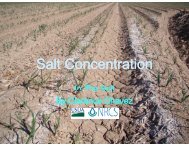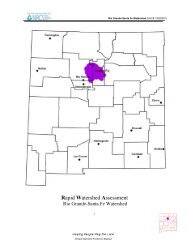SAMPLING VEGETATION ATTRIBUTES - New Mexico NRCS - US ...
SAMPLING VEGETATION ATTRIBUTES - New Mexico NRCS - US ...
SAMPLING VEGETATION ATTRIBUTES - New Mexico NRCS - US ...
Create successful ePaper yourself
Turn your PDF publications into a flip-book with our unique Google optimized e-Paper software.
METHODS—Density<br />
English measurements can be substituted but metric tapes are preferred.) At<br />
least three tapes are required (one, to be used for constructing quadrats, need<br />
only be as long as the long side of the quadrat; a rope of the desired length can<br />
be substituted for this tape); four are better.<br />
• Meter sticks (or yard sticks if using English measurements). Two are required.<br />
• Four stakes: 3/4- or 1-inch angle iron not less than 16 inches long<br />
• Hammer<br />
• Permanent yellow or orange spray paint<br />
• Tally counter (optional)<br />
• Compass<br />
• Steel post and driver<br />
5. Training As with any monitoring method, adequate training is essential to<br />
minimize nonsampling errors.<br />
a Examiners must be able to identify the target plant species.<br />
b For sod-forming grasses and other species for which individual plants might be<br />
hard to distinguish, written guidelines should be provided on what constitutes<br />
an individual unit to be counted. 6 This will help to ensure consistency among<br />
examiners. To assess consistency prior to the study, several examiners should be<br />
asked to independently count these units in the same set of quadrats and the<br />
results compared. If relatively consistent results cannot be achieved a different<br />
species should be chosen for estimation or a different method selected.<br />
6. Establishing Studies Careful establishment of studies is a critical element in<br />
obtaining meaningful data.<br />
a Site Selection The most important factor in obtaining usable data is selecting<br />
representative areas (critical or key areas) in which to run the study (see Section<br />
II.D). Study sites should be located within a single plant community within a<br />
single ecological site. Transects and sampling points need to be randomly located<br />
within the critical or key areas (see Section III).<br />
b Pilot Studies Collect data on several pilot studies to determine the number of<br />
samples (transects or observation points) and the number and size of quadrats<br />
needed to collect a statistically valid sample (see Section III.B.8).<br />
(1) Quadrat size and shape It is vital to choose the quadrat size and shape<br />
that will give the highest statistical precision for the area and key species<br />
being sampled. As a general rule of thumb long, thin quadrats are better<br />
6 Determination of what constitutes a unit to be counted is somewhat arbitrary. For rhizomatous grasses such as<br />
western wheatgrass (Pascopyrum smithii), each culm group can be visualized as an actual or potential plant<br />
unit, as can rooted stoloniferous units of such species as vine mesquite (Panicum obtusum). Mat or sodforming<br />
plants such as blue grama (Bouteloua gracilis) or alkali sacaton (Sporobolus airoides) usually start<br />
growth as small, distinct clumps, but may spread to plants a meter or more in diameter. As this occurs they<br />
tend to fragment into more-or-less separate units, and it is these separate units that should be counted as<br />
actual or potential individuals. For rhizomatous or mat-forming forbs, flowering stems may be the units<br />
counted. The examiner should ensure, however, that a change in the unit chosen is of biological significance,<br />
i.e., reflects a real change in the vegetation community. If it has no such significance, then another unit or a<br />
different species should be chosen. (Alternatively, an attribute other than density can be selected for monitoring.)<br />
95




